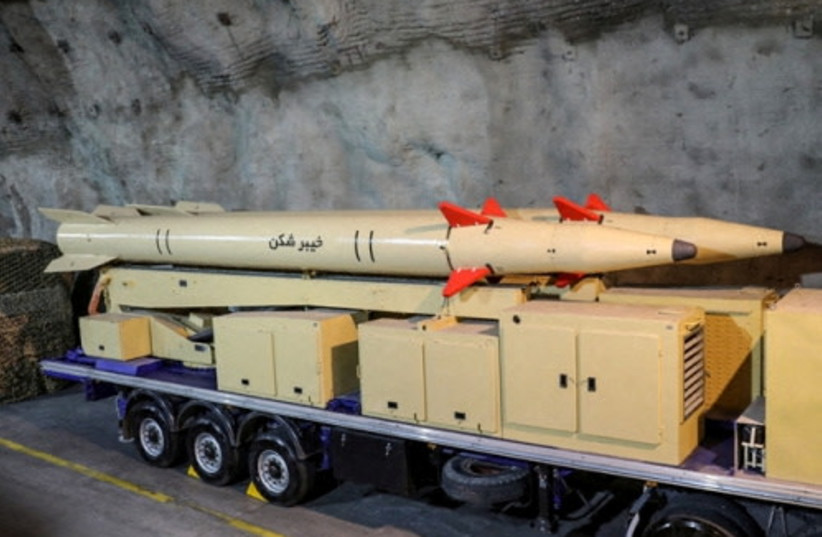by Seth J. Frantzman
Iran’s media didn’t link the missile directly to attacks on Israel when it first announced the new weapon and new name, but its range means it could reach Israel from western Iran.
 |
The Battle of Khaybar.
(photo credit: Wikimedia Commons)
|
Iran announced a new missile this week that it claims has a range of 1,450 kilometers, which means it can reach Israel from western Iran. The missile is called “Khaybarshekan” or “Khaybar breaker,” apparently a reference to a historic battle against Jews in the early Islamic period.
The chant “Khaybar, Khaybar ya yahud” is often used as part of antisemitic chants in the region, encouraging the mass murder or genocide of Jews.
There is no doubt that references to Khaybar have been used in the region as a battle cry against Israel and the Jews. The American Jewish Committee noted that antisemitic protests that swept Europe and the US during the May war between Israel and Hamas included chants of this nature.
“Antisemitic protesters in Brussels chanted ‘Khaybar khaybar, ya yahud! Jaysh Muhammad sa-ya’ud,’ or, ‘Remember Khaybar, O you Jews, Muhammad’s army will come back to you’ – a reference to a battle in which the Prophet Muhammad and his armies decimated a Jewish community in the year 628, that has become an Islamist battle cry against Jews,” the AJC report said.
Iran’s media did not link the missile directly to attacks on Israel when it first announced the new weapon and new name. It says the weapon is a third-generation strategic missile developed by the IRGC that uses solid fuel. It was unveiled by Amir Ali Hajizadeh when he visited a missile base. “The Khyber Breaker strategic missile is one of the third-generation of long-range missiles of the Islamic Revolutionary Guard Corps, which has unique features,” the Tasnim report said in Iran.
 New Iranian ''Kheibarshekan'' missiles are seen in an undisclosed
location in Iran, in this picture obtained on February 9, 2022. (credit:
IRGC/WANA (West Asia News Agency)/Handout via REUTERS)
New Iranian ''Kheibarshekan'' missiles are seen in an undisclosed
location in Iran, in this picture obtained on February 9, 2022. (credit:
IRGC/WANA (West Asia News Agency)/Handout via REUTERS)There are questions on whether Iran’s name for the missile is meant to conjure up old Islamic battles and influence public opinion in the region. The Islamic Republic may be trying to openly or subconsciously reference an ancient battle between Muslims and Jews, as a way of trying to assert that modern-day Iran is the current incarnation of the early Muslim period, the “true Islam” in this sense, and that it is fighting “the Jews.” It is doing this without openly saying so, because Iran’s regime pretends it is not antisemitic, even when it issues antisemitic dog whistles.
A search through Iranian major media returns some references to the battle of Khaybar. One article at Tansim notes about the ancient battle that “this area was under the control of the Jews during the time of the Prophet of Islam, peace be upon him and his family. There were about six, according to legend, [or] seven castles in the Khaybar region, built by the Jews. They built a watchtower next to each castle to monitor the entry and exit of people to the castle, and the guards who placed the watchtowers reported the entry and exit of the people to the heads of the castle. In the war that took place between the Muslims and the seditionist Jews of Khaybar…”
According to other articles in Iranian media, the historic battle included a scene in which the Jewish fort had a large gate that had to be broken down. In this rendition, the “breaking” or “busting” of the gate could be a reference to the missile’s current name. However, another reference in Mashregh News notes that the word is connected to not “breaking” or “sabotaging” a pact.
The word also appears in a Tasnim article that references the “Khaybar-breaking spirit” of the fighters of the Iran-Iraq war when Iran fought against Saddam Hussein’s Iraq. In this article, the reference to the breaking down of the Khaybar gate is clear, being used to describe the liberation of Khorramshahr from Iraq’s forces in 1982. The name of the operation used by Iran’s commanders was Operation Beit al-Muqaddas, which is a reference to Jerusalem.
Clearly, the name is thus used to describe the warrior qualities that Iran believes it possesses, and which it references with names from the early Islamic period. It matters whether this is all packaged in this new missile as a direct threat to Israel, because Tehran has announced a range that clearly means it can reach the Jewish state.
Iran’s purpose is to threaten but using coded language. It has toned down some of its threats against Israel in recent weeks, however, as it awaits the outcome of the Vienna nuclear talks.
Seth J. Frantzman
Source: https://www.jpost.com/middle-east/iran-news/article-695958
No comments:
Post a Comment